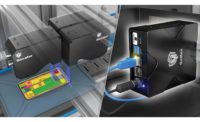In quality assurance, color measurement and spectrophotometry are essential in determining a product’s color consistency and accuracy, whether that measurement be in the industrial, textile and automotive industries or in the wide ranging variants of food production, pharmaceuticals, plastics and chemical manufacturing.
The process for quantifying color is complex but also objective and quantifiable, contributing to a future in which precision will be continually perfected, digital workflow will be seamlessly integrated and safe, reliable products will remain priority number one.
What is Color Measurement Today?
“I see color measurement today as the use of an instrument, either a colorimeter or spectrophotometer, to provide an objective description of a color under a standardized set of conditions,” says Diane Geisler, director, global communications at Datacolor. “These objective descriptions can then be used for quality control — comparing one sample’s color against a target without worrying about the variations in human color perception. Or in other cases, the objective color description is used for the formulation of ‘recipes’ to reproduce a certain color on a given substrate or material using pigments, dyes or colorants.”
Ken Phillips, market development manager at Hunterlab, explains further, “Color measurement is an aspect of quality assurance and quality control used to detect the presence or absence of color, to quantify a product’s color in ‘color space,’ and to compare a products color to that of a known standard for ‘pass/fail’ purposes during incoming raw material QC and during production.”
One example of this “pass/fail” model is when manufacturers are putting parts of a car together.
“It is critical that when two pieces of the same color are joined together, they are in ‘color harmony’ with one another, achieving the esthetic intentions of the designer,” says Phillips. “If the side mirror or bumper of a car does not match the exterior of the vehicle, these components are considered to be defective and not in ‘color harmony.’ The cost to the supplier of these components to fix such a problem can be excessive.”
Why is Color Measurement Important?
“Color measurement is an important element to a company’s quality initiatives for several reasons,” Phillips continues. “For some industries, such as food and beverage, color sells product, from the product itself to the packaging that contains the product… For other industries, such as food and pharmaceutical, both of which are highly regulated by the Food and Drug Administration (FDA) and similar regulatory bodies around the globe, color measurement is an important tool to understand a manufacturing process and to prevent contamination of a product.”
“Color harmony is one of the primary drivers for a consumer’s perception of quality,” adds Geisler. “As discovered from the research conducted by the secretariat of the Seoul International Color Expo in 2004, color and visual appearance is one of the most important factors in the consumer decision making process.”
Where is Color Measurement Headed?
Phillips describes the future of color measurement as “beyond color” and into an exciting new world of “color process automation technology.”
“Color measurement is ‘beyond color’ to new and affordable solutions that measure more color, but also measure appearance—those surface attributes such as texture and gloss—that have an impact on the observed color of any product,” says Phillips.
He also describes new color process automation technologies (cPAT) that provide real-time color data taken directly from the process stream and sent to a closed-loop color control solution, enabling automatic adjustments of pumps, feeders, valves and motors based on the colorimetric data received from the color measurement instrument.
“Most color measurements of color critical samples are done in a laboratory using state of the art spectrophotometers that can measure the reflected or transmitted color of a sample,” Phillips explains. “More and more companies however, are investing in cPAT, which is becoming more popular due to advancements in technologies that enable the design and manufacture of instruments that are smaller and take up less space on a production line, do not require special shrouding to occlude ambient light, deliver enhanced features and performance and are more cost effective than those solutions of 10, 20 and 30 years ago. The benefits of cPAT include improved manufacturing efficiencies, reduced operator error and costs, and reduced quality costs—scrap and customer costs associated with defective product.”
Adds Geisler, “Color measurement today is primarily focused on solid colors. Color measurement for the near future is focused on enabling the objective characterization of color on materials that cannot be easily measured today such as prints, heathers, laces and woodgrains. In addition, we [are seeing] many advancements to make color measurement more affordable and easier to use by all industries.”
How are Goals Changing?
“The rapid globalization of industrial supply chains has created an urgent need to efficiently qualify materials at a variety of manufacturing sites across the world,” Geisler notes. “For example, a car may receive its headliner from a plant in Mexico, the leather trim for the seat from Turkey and the vinyl for the dashboard from the United States. All of these different components must have the same color appearance to achieve the interior harmony intended by the designer and valued by the customer. This level of coordination is creating a demand for the digital communication of standards, as well as for a more efficient means of managing data globally.”
Phillips also believes that the focus will and should remain on streamlining workflow and continuing to make improvements to better meet the needs of companies and consumers.
“In the past, the goal of color measurement was narrow in focus, basically that of understanding the color properties of a particular sample or product and its difference when compared to a standard,” Phillips recalls., “Today, it is about understanding a process so that the process can be improved. The ability to collect data at multiple points throughout a workflow, and share that data within an organization or supply chain where it can be acted on, is critical in helping companies to improve their processes, reduce operating costs, improve efficiencies and improve stakeholder and shareholder value.”
“Color measurement instruments today that leverage modern technologies like Wi-Fi and Bluetooth for remote data transfer, and that enable seamless integration into a user’s digital workflow environment linking to ERP, SCADA or LIMS systems, that use modern tablet platforms for mobility and information on the fly from anywhere around the world, these are the needs of the modern business,” Phillips continues. “Products that deliver to these needs will continue to be well accepted and lead the way to new and exciting technologies into the future.”





